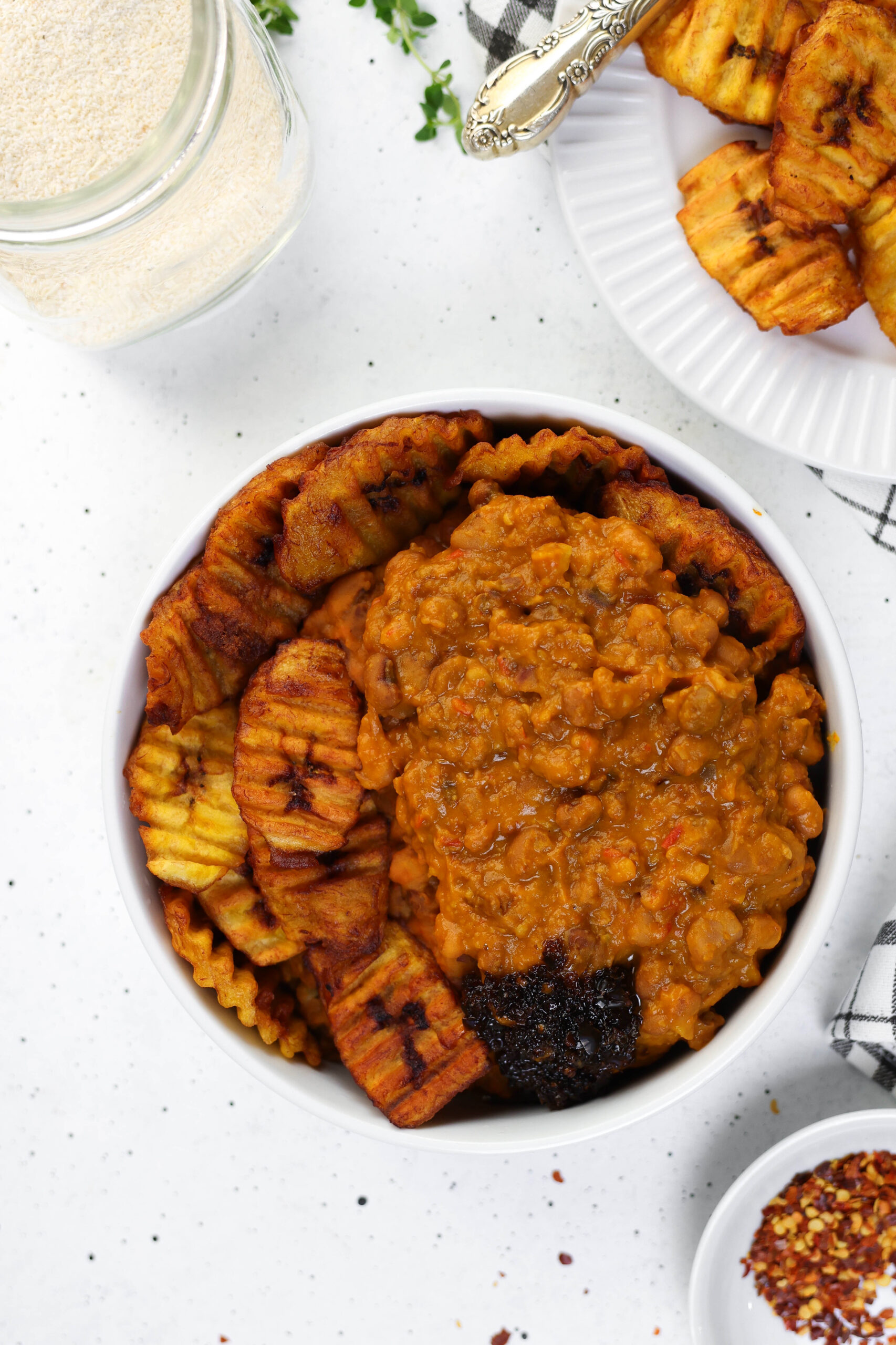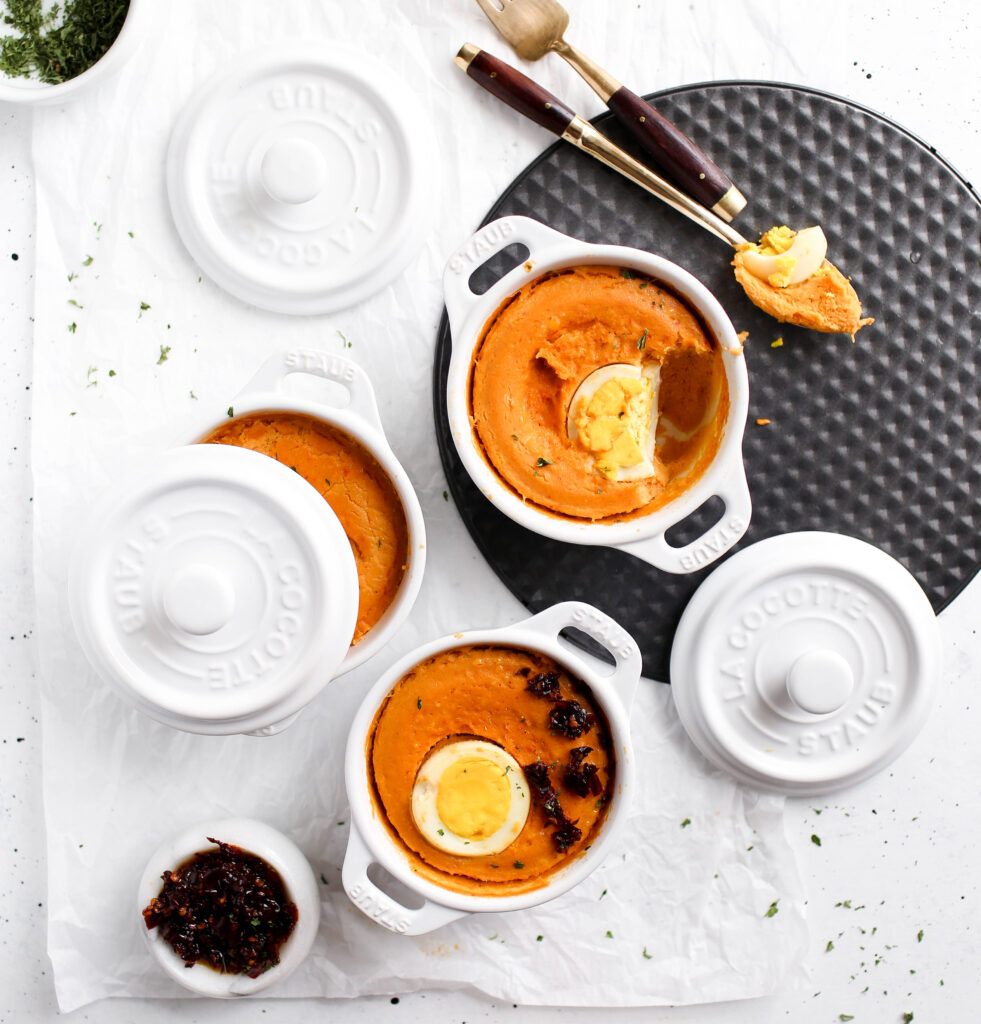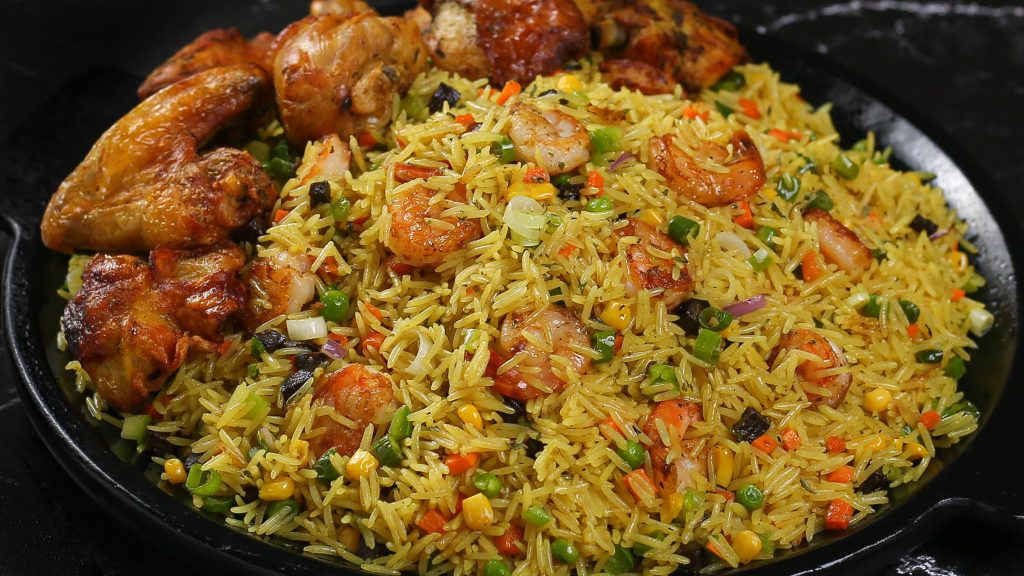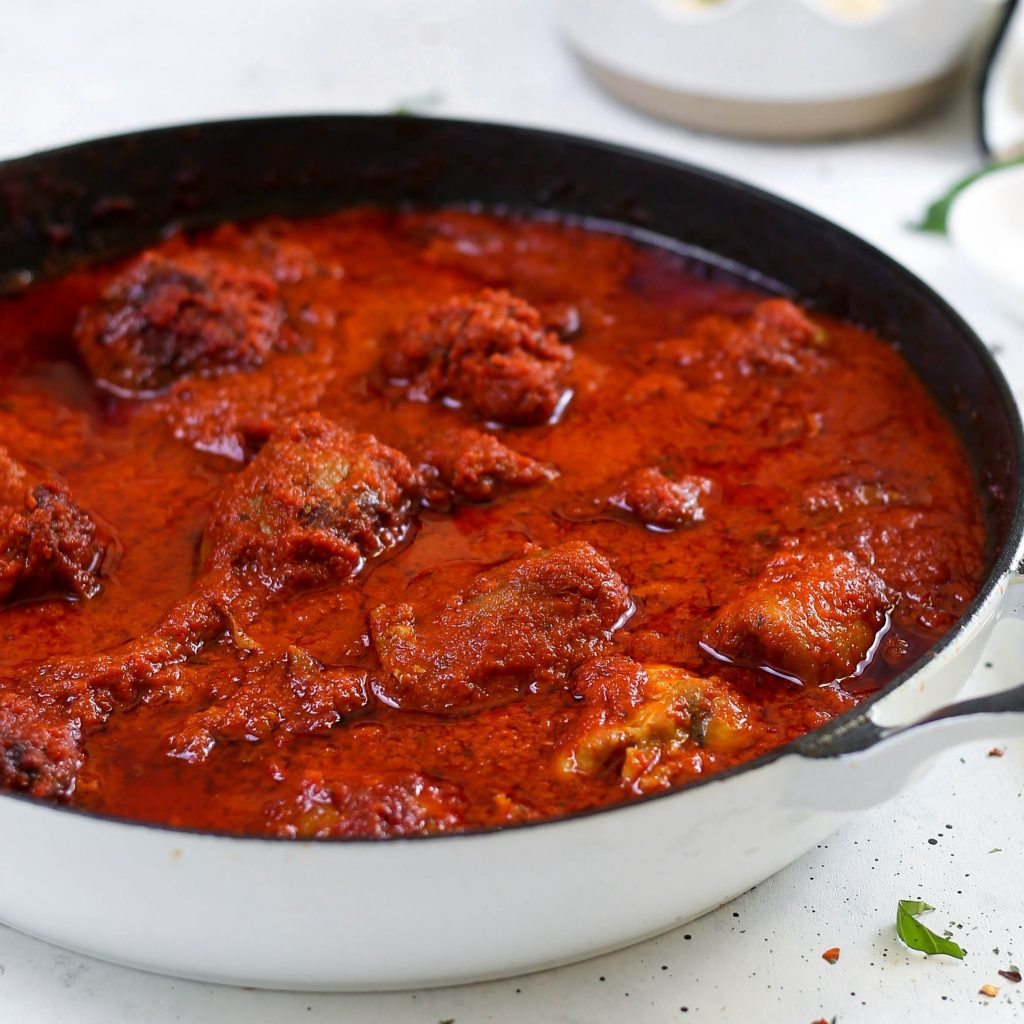nigerian beans pottage
I used to be a die-hard beans hater. I mean I unapologetically hated beans! Coming home from primary school to see beans on the menu? Instant mood killer. My mom would insist my siblings and I finish our plates, claiming it would make us grow tall. Sure, Mom! like that was happening because of beans! But one day, something changed, and just like that, I found myself loving beans.
Now, I can’t get enough of it. It’s so versatile, you can pair it with anything: bread, garri, plantain (yes, I do all three at once when I make beans, and I’m not even ashamed. Big “back” behavior, I know!).
Let’s dive into making my now favorite beans dish together!
Main Ingredients and Substitutions
Beans: I love using honey beans, also known as Ewa Oloyin. They’re lighter in color, naturally sweeter, and tend to cook faster than regular brown beans. However, you can easily substitute them with brown beans if needed. If neither honey beans nor brown beans are available, black-eyed peas are a great alternative.
Pepper Mix: I use a blend of onions and ata rodo (Scotch bonnet peppers). If you’re outside Nigeria, keep in mind that Scotch bonnet peppers found abroad are usually spicier than those in Nigeria. For this recipe, 1/2 to 1 of the foreign Scotch bonnets should suffice. You can also add bell peppers to the mix to balance out the heat. If Scotch bonnets are unavailable, habanero peppers make an excellent substitute. For a milder flavor, be sure to remove the seeds and veins from the peppers.
Palm Oil: Palm oil is traditional and gives the pottage its rich color and distinctive flavor. However, you can substitute with vegetable oil if needed. While it won’t have the same authentic taste as a classic beans pottage, the result will still be flavorful.
Seasoning: I like to keep my seasoning simple when making beans…just beef bouillon cubes and salt do the trick. However, chicken or vegetable stock cubes also work well as alternatives. To enhance the flavor, you can add crayfish powder or fish powder if you enjoy a touch of seafood in your dish.

How to Prepare Beans in a Pressure Cooker
If you want to make beans pottage quickly without the long wait, a pressure cooker is your best friend. There are two common types: electric and manual.
Using an Electric Pressure Cooker (instant pot, etc)
Electric pressure cookers, like the Instant Pot or similar brands, are user-friendly and come with settings to control both cooking time and pressure.
Option 1: One-Pot Method
Begin by picking through the beans to remove any stones or debris.
Place beans in the pressure cooker and add enough water to cover the beans. The water should be barely above the beans.
Add a handful of chopped onions, half the salt, and half a beef bouillon cube.
Lock the lid, set the pressure to medium, and close the vent. Set the timer for 20-25 minutes. Honey beans typically cook in 20 minutes, while brown beans may require the full 25 minutes.
After the cooking time is up, let the pressure release naturally for about 10 minutes before opening the lid.
While the beans is cooking, blend onions and peppers for the pepper mix.
Heat palm oil in a wide pot, then add the blended mix along with the remaining seasoning. Fry on medium heat for about 20 minutes until the mix dries out.
Once the beans is done, add them to the pot with the fried pepper mix, along with the water from the cooked beans (or regular water).
Stir well, cover, and allow the pottage to cook on low-medium heat for another 5-10 minutes to let the flavors come together.
Option 2: Sauté Setting Method
If your electric pressure cooker has a sauté function, use it to heat the palm oil.
Add the blended onions and peppers to the hot oil and fry with the seasoning until the mix becomes dry and grainy.
Add the washed beans, pour in enough water, and cover.
Switch the setting to “Beans” and set the timer for 20-25 minutes. Honey beans should be done in 20 minutes, while brown beans may take the full 25 minutes.
Using a manual pressure cooker.
Place the washed beans into the pressure cooker. Add water to cover the beans; the water should be just above the level of the beans.
Add a handful of chopped onions. Add half of the required salt.
Lock the lid of the manual pressure cooker securely. Set the pressure to medium and make sure the vent is closed.
Set a timer for 20-25 minutes.
After the timer goes off, allow the pressure to release naturally for about 10 minutes before opening the lid.
Once the beans is done, transfer it to the pot with the fried pepper mix.
⚠️Warning for Using a Manual Pressure Cooker⚠️
Avoid clogging the vent, which could lead to dangerous pressure buildup and ONLY open the lid once all pressure has been fully released. Opening a pressurized cooker can cause serious injury.

How to Serve Nigerian Beans Pottage
Beans pottage is versatile and can be served in many delicious ways, depending on your mood or what you have in the kitchen.
One classic pairing is fried plantains (dodo). The sweetness of fried ripe plantains complements the pottage beautifully. You can cut the plantains into cubes, slices, or crinkle cuts (my personal favorite).
Pair it with garri. Enjoy with soaked garri, and you can add sugar and/or milk if you like. Some people, and by some people I mean me 😁, love to sprinkle garri over their beans for added texture and crunch.
Serve with soft, fluffy bread (like Agege bread). This helps soak up the rich bean sauce. You can also place the beans between a burger bun and enjoy it like a sloppy Joe. Yum yum!
For a fun twist, try a beans wrap. Wrap the beans in your favorite pita or shawarma bread, toast it, and enjoy.
You can also serve the beans alongside fried fish or beef for extra protein and flavor.
Beans and pap (ogi) is another delicious option. The creamy texture of the pap perfectly balances the heartiness of the beans. Serve it hot for a comforting breakfast.
Last but not least, for a hearty twist, consider serving your beans pottage over rice for a classic beans and rice combination.
Pro Tips for the Best Nigerian Beans Pottage
One of the common complaints about eating beans is the potential for heartburn or bloating. To avoid heartburn when eating beans, try soaking the beans before cooking. Soaking it for a few hours (or overnight) and discarding the water helps remove some of the complex sugars that cause gas. You can also parboil the beans by boiling them for about 30 minutes, then throwing out the water, adding fresh water and salt, and cooking until done.
For the pepper mix, frying it until the oil separates is essential for deepening the flavor and adding a distinct “fried” taste to your pottage. This should take about 10-15 minutes on medium heat, so don’t rush this step.
If you want a smooth, creamy texture, cook the beans until they begin to break apart. You can also mash some of the beans against the side of the pot with a spoon to achieve that thick, luscious consistency.
Additionally, don’t skimp on the palm oil. Palm oil adds both flavor and color to the dish. If you prefer a lighter version, you can reduce the amount, but avoid omitting it entirely unless you’re making a specific variation of the dish.
For a more filling meal, consider adding chopped boiled yam or plantain halfway through cooking. You can also stir in some cooked corn for additional flavor and texture.
FREQUENTLY asked quEstions
Does adding salt or seasoning to the beans make it cook unevenly?
No, it doesn’t. Unevenly cooked beans are mostly a result of mixing different types of beans during sale or packaging. I cook beans all the time and add salt, and I’ve never experienced unevenly cooked beans.
Does adding a metal spoon make my beans cook faster?
Not to the best of my knowledge. I did a little experiment of my own and found that this has no effect on the cooking time.
What’s the best place to store my uncooked beans?
I usually store mine in the deep freezer. This prevents weevils. You can also store them in an airtight container for short-term storage.
How do I prevent heartburn when eating beans?
To prevent heartburn when eating beans, soak the beans for a few hours or overnight before cooking and discard the soaking water. This helps remove some of the complex sugars that can cause gas.
How to store/reheat cooked beans:
Store the cooked beans in an airtight container in the refrigerator for up to 4-5 days. To reheat, you can warm them on the stovetop or in the microwave, adding a splash of palm oil or water to prevent it from drying out. If you have a larger batch, you can also freeze them in portions for longer storage. When ready to eat, simply thaw and reheat.
Make-Ahead
To prepare in advance, cook the beans separately and fry the sauce. Store both in an airtight container or a ziplock bag and freeze until you’re ready to use them. This way, you can have a delicious beans pottage ready to enjoy whenever you need it.

Ingredients
- 3 cups beans
- 4 cups water
- 1 tsp salt
- 1 large onion
- ½ large bell pepper
- 1/2 -1 Scotch bonnet pepper
- 1/3 cup oil
- 1/2 teaspoon salt
- 1 beef seasoning cube
- Extra 1/4 – 1/2 cup Water
Instructions
Using a Gas Stove:
- Pick and rinse the beans.
- Chop ½ of the onion.
- In a large pot or pressure cooker, add the beans, chopped onion, and ½ of the salt.
- Add enough water to cover the beans, then cover the pot and cook for about 40-60 minutes or until the beans is soft. Keep checking and adding more water as needed to prevent burning.
- Blend the remaining onion, bell pepper, and atarodo.
- In a separate pot, heat the oil.
- Once the oil is slightly hot, add the blended mixture.
- Season with the remaining spices, stir, and fry for about 10-20 minutes on low heat.
- When the beans is ready, add it to the pot with the sauce.
- Stir-fry for a few minutes, then add any leftover water from the beans or regular water.
- Cover and allow to cook on low-medium heat for about 5-10 minutes.
- Stir, serve and enjoy!
Using an electric pressure cooker: (instant pot)
- Pick the beans to remove stones and dirt
- Place beans in the pressure cooker and add enough water to cover the beans. )The water should be barely above the beans.)
- Add a handful of chopped onions, half the salt, and half a beef bouillon cube.
- Lock the lid, set the pressure to medium, and close the vent.
- Set the timer for 20-25 minutes. Honey beans typically cook in 20 minutes, while brown beans may require the full 25 minutes.
- After the cooking time is up, let the pressure release naturally for about 10 minutes before opening the lid.
- While the beans is cooking, blend onions and peppers for the pepper mix.
- Heat palm oil in a wide pot, then add the blended mix along with the remaining seasoning.
- Fry on medium heat for about 20 minutes until the mix dries out.
- Once the beans is done, add it to the pot with the fried pepper mix, along with the water from the cooked beans (or regular water).
- Stir well, cover, and allow the pottage to cook on low-medium heat for another 5-10 minutes to let the flavors meld.
Using a manual pressure cooker.
- Place the washed beans into the pressure cooker. Add water to cover the beans; the water should be just above the level of the beans.
- Add a handful of chopped onions. Add half of the required salt. Add half a beef bouillon cube for flavor.
- Lock the lid of the manual pressure cooker securely. Set the pressure to medium and make sure the vent is closed.
- Set a timer for 20-25 minutes. Honey beans typically cook in 20 minutes. Brown beans may need up to 25 minutes.
- After the timer goes off, allow the pressure to release naturally for about 10 minutes before opening the lid.
- While the beans is cooking, blend onions and peppers to create a pepper mix. In a wide pot, heat some palm oil on medium heat. Add the blended onion and pepper mixture, along with the remaining salt and bouillon cube. Fry the mixture for about 20 minutes until it dries out.
- Once the beans is done, transfer to the pot with the fried pepper mix. Add the cooking liquid from the beans (or regular water if needed) to the pot.
- Stir well, cover, and let the beans and pepper mixture cook on low-medium heat for 5-10 minutes, allowing the flavors come together.
- Serve and enjoy.
Did you make this recipe?
Tag, mention or DM @kikifoodies. I would love to hear from you!




